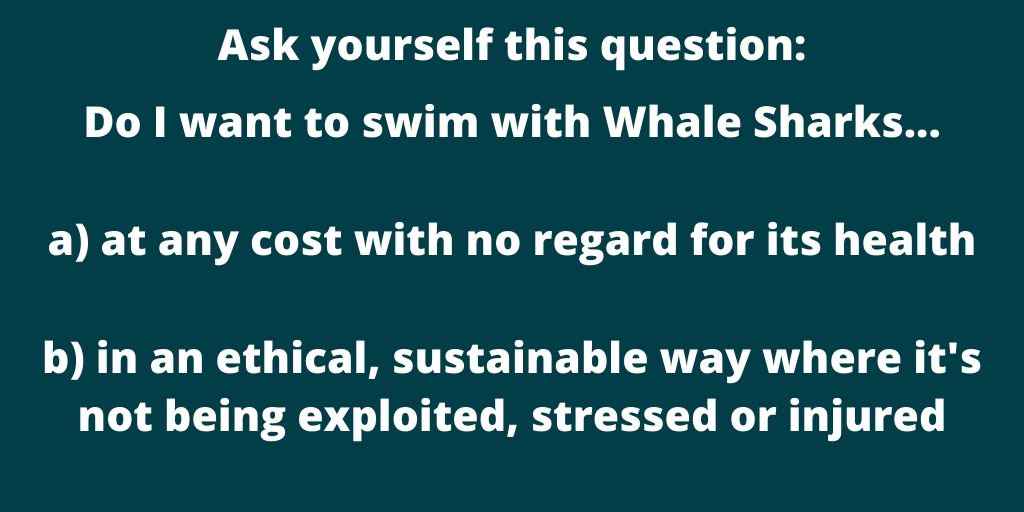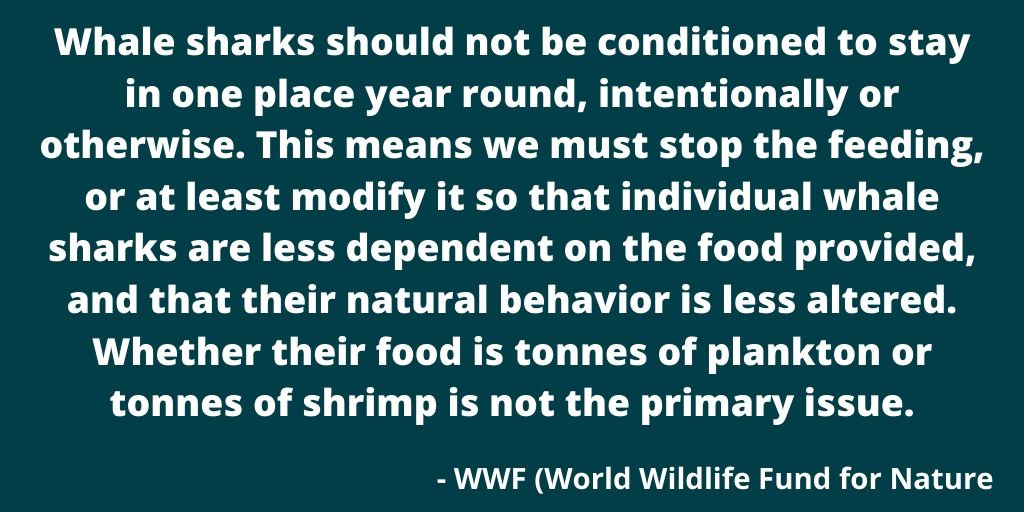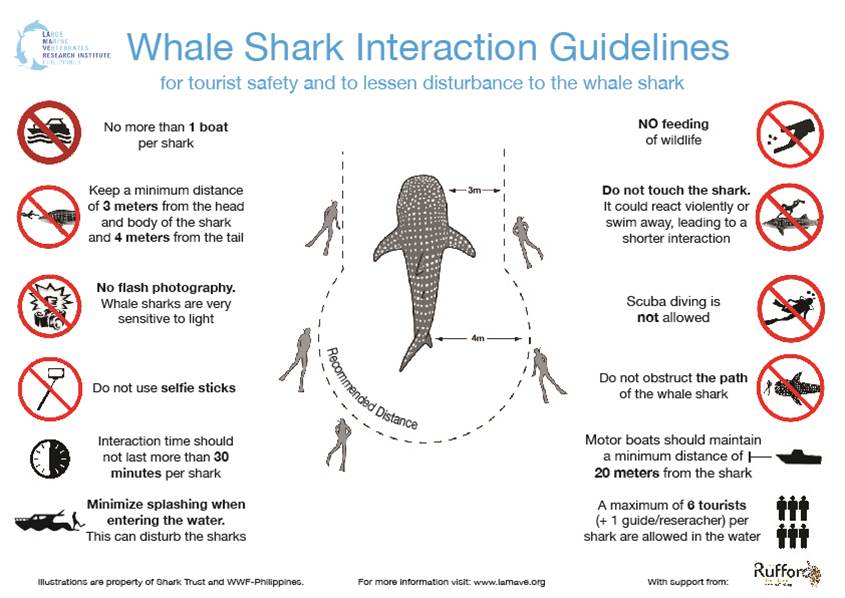|
One of the top things to do in Cebu, Philippines is swim with the Oslob whale sharks. However, questions regarding whether or not it is ethical are constantly asked, and concerns raised by WWF, Greenpeace, National Geographic and Marine WIldlife Watch for a species classified as “vulnerable to extinction” are real.
The whale sharks in Oslob are hand fed to guarantee sightings for tourists 365 days a year. It’s showing no signs of slowing down, in fact it’s the opposite. Tourist agencies boast “99% guarantee of seeing the whale sharks”. Are these whale sharks ambassadors for the marine world or just being exploited for money? Outside of the Philippines, safety of the whale sharks is threatened by the illegal global shark fin trade, and they are considered to be one of the most vulnerable marine species in the world. Should we be jeopardising the health and mating routines of a vulnerable to extinction species? Are the Oslob whale sharks helping people from around the world respect them more? What are the chances of people involved in the global shark fin trade visiting Oslob, falling in love with the whale sharks then deciding not to take their fins? Whale shark tourism in Oslob is about money, BIG money, and it’s a lucrative multi-million dollar business which have received 2,000 visitors PER DAY at certain times of the year. Moalboal Eco Lodge have carried out extensive research to ask, is Oslob whale shark watching ethical?
Before this post discusses whether or not whale shark watching in Oslob is ethical, and whether this particular animal tourism is sustainable for the species, I will state that Moalboal Eco Lodge do not support or run whale shark watching tours to Oslob.
Knowing what we know now, which includes recommendations by WWF (World Wide Fund for Nature), Greenpeace, National Geographic and Marine Wildlife Watch not to swim with the whale sharks in Oslob, we do our best to inform people of the facts we have discovered. In the past, there have been no restrictions on numbers at Oslob, and as many as 100+ people have been seen in the water around the whale sharks. This is stressful for the whale shark and will have an impact on its survival. With no trained personnel, the three metre distance rule and “no touching” laws aren’t enforced. Feeders have been observed pushing whale sharks away with their feet in an attempt to discourage them from feeding, and Instagram and the internet are full of selfies showing people holding onto the whale sharks, touching the whale sharks or at the very least breaking the three metre rule. A survey by the non-profit organisation LaMaVe (Large Marine Vertebrates Research Institute Philippines), who have been observing the whale sharks daily since 2012, carried out a study which showed that on average a whale shark was touched 29 times every hour.
Some of our guests’ have independently booked an Oslob whale shark watching tour. They reported how much of a circus it is, and how they didn’t think it would be that bad. Your experience will not be the personal encounter you envisage.
A visiting travel blogger stated “I wish I could say I enjoyed swimming with the Oslob whale shark, but I didn’t. I am saddened by what I saw; the chaos of tourists which would scare away or harm the poor whale shark, stubborn tourists touching the whale shark. The number of tourists should really be controlled”. I confess it upsets and saddens me when someone tells me they know it is bad, but they want to do it anyway. Sadly Instagram, social media and Tinder have increased people’s desire to add animal tourism to their bucket list, and not in a good way. Instagram selfies posted by “influencers” receive thousands of likes which encourages travellers to want the same experience. These tourists don’t know, or often don’t care about the long term effect their visit has on the species. All people want is the selfie and to say they have done it.
What is ethical animal tourism?
Ethical animal tourism is a wildlife encounter where humans do not have any involvement. This means no touching, no feeding, the animal is not caged or held against its will. If you speak to any marine conservationist, environmental advocate, ocean lover or responsible diver they tell you snorkelling in Oslob should not be done. WWF (World Wildlife Fund for Nature) said in an official statement December 2016 “Whale sharks should not be conditioned to stay in one place year round, intentionally or otherwise. This means we must stop the feeding, or at least modify it so that individual whale sharks are less dependent on the food provided, and that their natural behaviour is less altered. Whether their food is tonnes of plankton or tonnes of shrimp is not the primary issue” Marine Wildlife Watch of the Philippines believe "It's irresponsible and unsustainable. It's not even ecotourism. You sacrifice the environment just for a selfie." In August 2018, National Geographic wrote an article sharing it’s concerns over the impact of whale shark tourism in Oslob, described as the “home of the whale shark selfie”. The article said Oslob was a chaotic world and stated “For every grinning Oslob tourist snapping a photo with a shark, could there be another who looks into the eye of that great spotted giant and sees something of immense intrinsic worth, whose existence must be protected? Or are these sharks primarily narcissistic props?” Greenpeace Southeast Asia stated “Conditioning whale sharks to approach boats can also make them more susceptible to injuries and poaching. The whale sharks’ positive association with boats may cause negative impacts when they move to other areas where there are no guidelines and trained personnel to conduct and monitor human interactions, as happens in neighboring countries.”
What is wrong with feeding the whale sharks?
So what is wrong with feeding the whale sharks? They aren’t caged, they are free to come and go as they please, they aren’t in pain, there is no drugging involved, they aren’t suffering, so why is feeding them so bad? The answer is simple – by feeding them, humans are changing their natural behaviour which has a long term damaging effect in many ways. Greenpeace Southeast Asia quoted “researchers have observed marked changes in the whale sharks’ behavior and physiology and concerns have been raised on the impact to the local environment.” Research carried out by LAMAVE have discovered some worrying facts. • The whale sharks are only in Oslob because they are being fed. The topology of the area is not suitable as a breeding ground. • The Oslob whale sharks are significantly smaller compared to the ones found elsewhere due to the lack of nutrition provided by fishermen. • Within one week of a new shark arriving in Oslob, scaring and injuries were seen on their fins, mouths and bodies which is partly due to overcrowding in the water and partly because of their familiarity with boats. • 47% of Oslob whale sharks have received cuts from propellers and boat injuries. • Whale sharks associate boats and humans with food. When they are on their migratory path, they will approach boats looking for food instead of swimming away from it, so if/when a whale shark leaves Oslob, it often mistakes the bubbles of a boat for food and they are hit by the propellers.
I would like to expand a little more on some of the above key facts.
Lack of proper nutrition Whale sharks in Oslob are significantly smaller compared to those found in other parts of the Philippines. The food they are fed by the fishermen isn’t nutritious enough which is affecting their growth and reproduction. It’s also not the fishermen’s aim to fill them with food, but to give them enough to keep the whale sharks hanging around wanting more, ensuring more tourists pay to see them. Missed opportunities for mating and giving birth It was reported that 13 whale sharks are hanging around Oslob and not taking their 20,000 km migratory routes between Philippines and Mexico. This means 13 whale shark are not contributing to the longevity of the species, because somewhere along their migratory route they find a mate and give birth. One individual stayed in Oslob for 572 days, and “Mr Bean” for 392 days. An endangered species such as the whale shark needs all the reproduction opportunities it can get. General health is suffering Whale sharks are surface feeders, and by hanging around Oslob for food, they are spending too much time in the shallows. Whale Sharks usually hang out around 50 metres but can dive as deep as 1,000 metres. It is believed they do this “to sleep”, to balance their body temperature and to rid themselves of parasites. Spending too much time at the surface makes them more vulnerable to disease, and their bodies are warmer which increases their stress levels. Stress in a wild animal can affect its survival as it changes the way they use their daily energy, how they grow, their immune system, reproduction and general health. Boat injuries are clearly visible Propellers are not used in Oslob, and this is where there are concerns. Whale sharks associating boats with humans and food are approaching boats on their migratory route. Some of the boats have propellers which is where they are obtaining the cuts, but more concerning, is they are making themselves easier for poachers to catch for their fins, gills and meat when they enter unprotected waters. They are not fulfilling their role in the eco system Whale sharks need to fulfil their role in the ecosystem by eating the plankton and krill that would otherwise cloud the oceans. If the oceans are cloudy this hinders the penetration of sunlight which is needed to help plants and coral growth, this in turn feeds other fish.
Who benefits from the Oslob whale sharks?
There is no denying that the village of Tan-Awan, a small fishing barangay/town in Oslob, has benefited hugely from whale shark tourism. Residents and fishermen have become rich, but unfortunately it is at the expense of the species. Sadly whale shark tourism in Oslob is not about protecting the species, or raising awareness for the species, it’s about money. The fishermen benefit, the municipality of Oslob benefits, but the whale sharks do not benefit at all. Here is the breakdown of how your money is spent: 60% to fishermen 30% Municipality 10% local village 0% towards whale shark conservation
Not one single peso, pound, euro, yen, yuan, won or dollar is spent on whale shark conservation at Oslob.
Ethical alternatives
Did you know Oslob is not the only place in the Philippines to view the majestic whale shark? Oslob is the most famous place, definitely the most popular, but there are a few other places tourists can swim with the whale sharks in the Philippines in an ethical way with no feeding, no touching, and with no danger to the species. Here in Moalboal, whale shark sightings are increasing, in fact whilst writing this blog post sitting in a local dive centre, a group of divers returned to say they had just seen one on house reef. How jealous do you think I was when I opted not to dive so I could finish this article – ironic eh! Yesterday a friend of mine posted a video on Instagram of a whale shark she had just seen. The above photo was taken by Kevin Gacad when diving at the sardines, the most famous dive site in Cebu. Whales sharks start their migratory journey in the Pacific (California or Mexico) ending in the Philippines which is part of the Coral Triangle, its nutrient rich waters providing the greatest marine biodiversity in the world. They enter the Philippines at two main entry points; the San Bernardino Strait between Luzon and Samar (for the Donsol whale shark sightings), and the Surigao Strait, between the Bohol Sea (also known as the Mindanao Sea) and the Leyte Gulf. Southern Leyte, Sogod Bay is the next island to Cebu and is a natural feeding station with plankton rich waters offering plenty of sustenance after their 20,000 km migratory journey from Mexico to the Philippines. November to April is whale shark season here. Donsol is another natural feeding station on the sharks’ migratory route. Donsol is more popular than Southern Leyte and there are more boats, however the experience is still sustainable with no feeding. Honda Bay, Puerto Princesa, Palawan has a different whale shark season running April – October. Tubbataha is also near Puerto Princesa, however it can only be accessed via a live-a-board. Tubbataha is a protected UNESCO World Heritage Site in a remote area. Not Whale Sharks - but Dolphin Watching in Alegria This is our short YouTube video of ethical dolphin watching in Alegria with Hostel La Vista. There is no feeding, no chasing, and you could be the only boat on the Tanon Strait viewing these beautiful dolphins. They are very playful, and love to swim alongside you.
How did whale shark tourism in Oslob begin?
Whale shark feeding was introduced in September 2011 by a dive centre. Fishermen in the small town of Tan-awan discovered by accident that whale sharks like shrimp (known locally as uyap) in the small town of Tan-awan, close to Oslob. Sharks would try to eat the bait from their fishing line so the fishermen would lure the whale sharks away from their boats by giving them small amounts of uyap. When a dive centre discovered this, they paid the fishermen to lure the whale sharks towards their dive guests.
In December 2011, the UK Daily Mail Newspaper printed a photo of a man holding onto a whale shark, and the explosion of whale shark tourism in Oslob began.
Within one year of introducing whale shark feeding, researchers noticed a change in the whale sharks’ natural behaviour which included eating and migrating patterns. Whale Shark Facts & Trivia Visit our Eco Shop* for your plastic free, zero waste, palm oil free products for use every day! (*10% from every purchase is donated to Moalboal Dog Rescue)
Where to stay in Moalboal, Cebu
When visiting Moalboal, Moalboal Eco Lodge is the perfect place to stay. Located in the middle of a peaceful field, it’s close enough to amenities, but far away so you can have a good night’s sleep. There is plenty of space to observe physical distancing at the Eco Lodge. Please read our COVID-19 Care page for more information regarding your safety. Nestled in amongst palm trees, bamboo and coconut trees, Moalboal Eco Lodge have Bamboo Nipa Huts suitable for solo travellers, couples and friends. We have two private rooms and a spacious 4-bed dormitory, a breakfast area, and a beautiful hammock/yoga/sunset deck. Bicycles are for hire if you wish to slow travel in the most environmentally friendly way, or you can rent a scooter. Take a look at our rooms!
For help regarding travel and Visa requirements, visit our Travel Information page
Staying in Cebu? Check out our Day Trips from Moalboal Series
Kawasan Falls, Badian Basdaku "White Beach", Moalboal Mantayupan Falls, Barili Lambug Beach, Badian Taginis Falls & Budlot Spring Montpellier Waterfall, Alegria Simala Shrine Castle Church, Sibonga Heading to the Philippines? Check out these related posts! Jeepney Street Art 28 Things to Do in Moalboal, Cebu Must-Try Filipino Foods Things You Should Know Before Visiting the Philippines Fun Facts About the Philippines
Pin this post for future reference!
0 Comments
Your comment will be posted after it is approved.
Leave a Reply. |
Archives
October 2023
Categories
All
|











